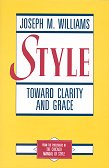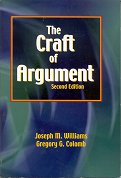Filled with realistic examples of good, bad, and better writing, and step-by-step strategies for crafting a sentence or organizing a paragraph, Style does much more than teach mechanics: it helps anyone who must write clearly and persuasively transform even the roughest of drafts into a polished work of clarity, coherence, impact, and personality.
Any book claiming to teach clear writing sets itself up to be examined by its own guidelines. This one can’t be faulted; the entire book is a joy to read. At the start, Williams cautions against devouring it in a single sitting; the various chapters should be thought about and reflected upon, and the ideas practised. But it is a hard caution to heed: the prose is so smooth and lucid, I just kept reading and reading.
I can’t summarise what this book is about any more clearly than the author himself, in his first two paragraphs:
But I want to do more than just help you write clearly. I also want you to understand this matter—to understand why some prose seems clear, other prose not, and why two readers might disagree about it; why a passive verb can be a better choice than an active verb; why so many truisms about style are either incomplete or wrong. More important, I want that understanding to consist not of anecdotal bits and pieces, but of a coherent system of principles more useful than “Write short sentences.”
And a coherent set of principles is precisely what he delivers. He starts with individual sentences, and the principle of clarity – writing a sentence that can be understood on first reading. He moves on to groups of sentences, then paragraphs, and entire documents. These should be written using the principles of cohesion, emphasis, and coherence, to produce paragraphs where the sentences work together to produce a unified whole. These higher level principles sometimes require breaking individual sentence principles – for example, when to occasionally use the passive voice. Finally he covers the principles of concision, length, and elegance – how to vary the structure to produce distinct, but still clear, style. At each step he lays out the principles clearly, with explanations, examples, and counter-examples.
The principles apply to revising text to make it clear, not to writing it in the first place. It is assumed you already have something to say; that something just needs to be said clearly. The principles are not easy sound-bite rules, they are concepts that require hard thought to apply when revising and re-revising. But they are well explained, and the underlying reasons why they work are also made clear, so that you can understand why they work – and how to modify them in different circumstances, to get different effects.
Indeed, there are scathing attacks on the “sound-bite” style of the grammar mavens. Most of these so-called rules are broken by good writers, which would imply they are not rules at all. But we do get given a good reason – a reason that leads to better writing, rather than simply placating the pedants – for preferring not to end a sentence with a preposition:
This is an excellent book. Read it, apply it, and you should be writing clearer and more stylish prose.

